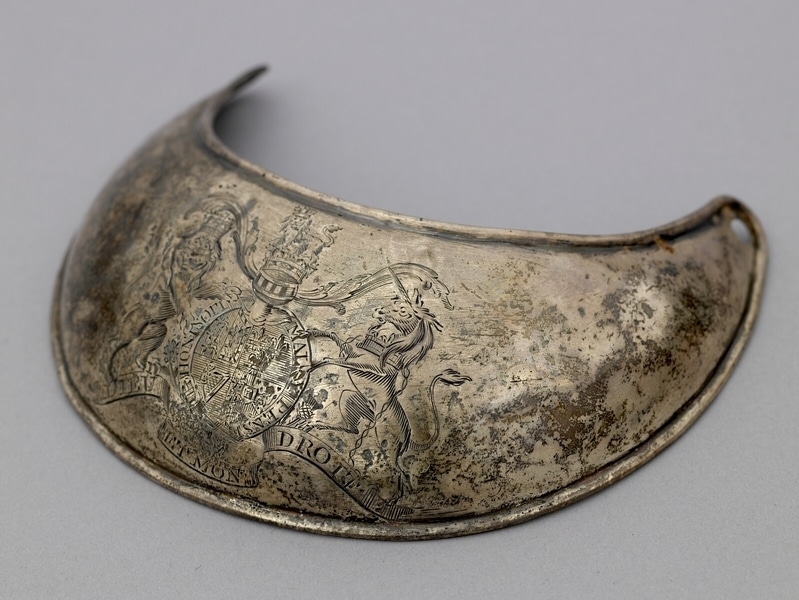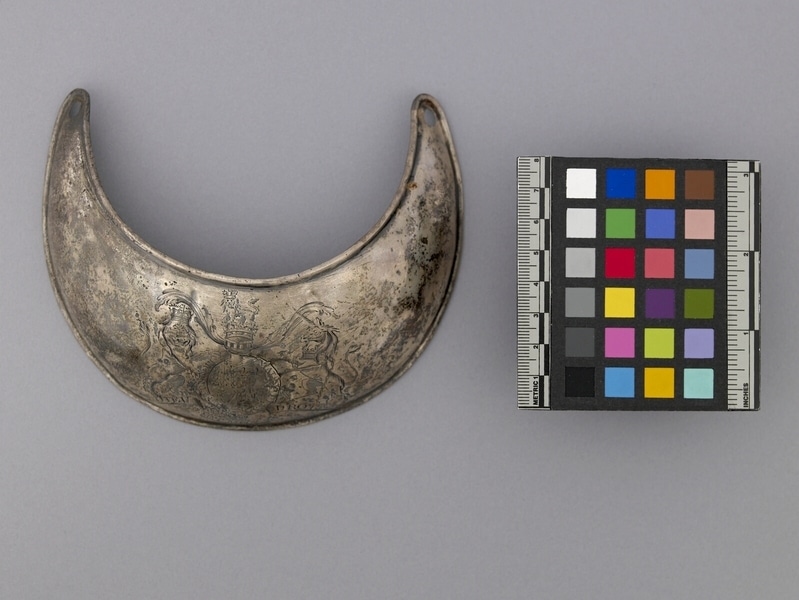Gorget Item Number: 1590/269 from the MOA: University of British Columbia


Description
Crescent-shaped gorget with rolled edge and a hole at each upper edge for suspension. There is a British coat-of-arms engraved on the centre front. Also engraved on the front are the words “ Dieu et mon droit. Honi soit qui mal y pense.” HB is engraved on the back.
History Of Use
In Europe during the Renaissance period the helmets of warriors were fitted with a crescent-shaped plate called a gorget, which extended downward to protect the throat. Gradually, this armour became obsolete due to the use of firearms, but some breastplates, helmets and gorgets were brought to North America for protection against native arrows. The use of this armour declined here too, in favour of increased mobility, but the crescent-shaped gorgets continued to be worn separately by officers as a badge of military rank and authority, and consequently had appeal as trade items denoting strength and power. Reference Hamilton, pages 69-71.
Silver ornaments represent an important part of early exchange between Europeans, including fur traders, and First Nations peoples, especially in eastern and central Canada and the U.S.A. Initially, the main source of silver was British, French and Spanish coins. Most ornaments were produced by silversmiths of European origin in North America and Europe, and were actively traded only from 1760 to 1821. By the mid-18th century silver objects were produced in New England, Quebec and Montreal. Silver was used by First Nations peoples as a sign of rank. Silver ornaments in these styles continue to be produced by native silversmiths in central Canada and the U.S.A.
In 1670 King Charles II of England granted an exclusive fur trading charter to the Hudson’s Bay Company in what was later to become Canada. The company’s mandate was to protect the Crown’s interests and undertake exploration and territorial expansion. Competition for furs was intense, and in 1784 the North West Company was formed by a number of independent trading groups. By 1821 this Company faced bankruptcy and merged with the Hudson’s Bay Company. This latter company still exists today, operating a number of retail stores across Canada, and is known simply as The Bay.
Cultural Context
trade; personal decoration; status
Item History
- Made by Hester Bateman (Manufacturer) in Europe between 1760 and 1821
- Owned by Kathleen E. Reif before September 9, 1993
- Received from Kathleen E. Reif (Donor) on September 9, 1993
What
Who
- Culture
- Eastern Woodlands
- Creator
- Hester Bateman (Manufacturer)
- Previous Owner
- Kathleen E. Reif
- Received from
- Kathleen E. Reif (Donor)
Where
- Holding Institution
- MOA: University of British Columbia
- Made in
- Europe
When
- Creation Date
- between 1760 and 1821
- Ownership Date
- before September 9, 1993
- Acquisition Date
- on September 9, 1993
Other
- Item Classes
- metalwork
- Condition
- fair
- Accession Number
- 1590/0269